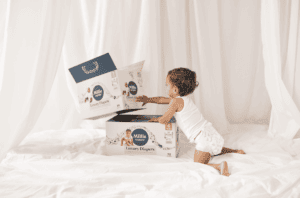If you have a small child, at some point, they will have a tantrum. It doesn’t matter how prepared you are, what a wonderful parent you are, or whether your child is (relatively) reasonable or rational. At some point, they will writhe on the floor, arch, shout, or physically express their overwhelm in some other way. A tantrum is developmentally normal in children, but as parents, we get worried, frustrated, embarrassed — you name it!5 We’re always looking for ways to support and care for our children when they become so distressed that they can’t regulate themselves.
Proprioception: A Lesser-Known Cause of Tantrums
Many things can cause tantrums to arise. They often occur because our little ones aren’t yet equipped to understand, communicate, and appropriately express their frustration.6 When a child doesn’t fully understand something, they can become fearful. Or when a child can’t do anything to help themselves, they can become overwhelmed. These types of events can turn into tantrums. These behaviors will subside in time once they express the emotion’s energy or have their need subsequently met.
Another cause of tantrums can be associated with sensory overwhelm.7 We typically understand that we have five senses: sight, hearing, taste, smell, and touch. But a less commonly acknowledged sixth sense is proprioception.4 Here’s everything you need to know about proprioception:
What Is Proprioception?
Proprioception is the body’s ability to sense itself.4,7 Essentially, messages guided by receptors in the body (like muscles, skin, and joints) tell our brain where our body exists in the space around it (bodily awareness).4 Proprioception also gives us valuable information about how much force we need to exert to impact things around us, like how hard we press on a pen to write and how tight we squeeze someone when we give them a hug or a handshake.4
Sensory sensitivity to noises, light, touch, etc., can make our children feel overwhelmed, fearful, and confused. The result can look very much like a tantrum.7 However, it’s important to note that what underpins a sensory meltdown is very different than a tantrum.8
How Is a Sensory Meltdown Different Than a Tantrum?
A sensory meltdown is a fight, flight, and freeze response the body has in response to sensory overload.7,9 It generally won’t subside until the removal of the overwhelming stimulus occurs, and the child can slowly regulate again. Tantrums have the purpose of eliciting a response or outcome. In contrast, sensory meltdowns exist in response to environmental triggers and generally aren’t in your child’s control.8
Children with proprioceptive processing issues or disorders may experience the following:10,11
- Feeling disjointed or scattered, or finding it hard to focus or retain attention
- Being clumsy and demonstrating poor control and bodily awareness, particularly when controlling or coordinating multiple body parts or actions (like riding a bike)
- Feeling exhausted or having poor postural control, feeling tired at holding their body upright, slumping, needing to rest their head when sitting or leaning, and having challenges standing on one foot
- Seeking sensory input, like tapping, clicking, chewing, biting, fidgeting, pushing/shoving, or playing too rough (being physically intense with others)
How Can You Support Your Child?
When the body struggles to regulate proprioceptive input, we need to address this physical need directly through “heavy work.”11 (Remember, proprioceptive input is information that tells the body important things about where it exists relative to other things, or it struggles to find the right level of pressure or force to use against other things.4) Although the strategy of heavy work can support those with diagnosed sensory processing disorders, ADHD, autism, etc., all children and adults can use it as a tool for their senses to help regulate and soothe after distress.1,2
What Is Heavy Work?
Heavy work helps our body get the proprioceptive sense organized. It refers to specific activities that push or pull the joints of our body, as this is where our proprioceptor receptors are.11,12 When we engage in work that requires us to use our muscles and flex our joints, our body sends messages to our brain, which reminds the brain (and our body) where it exists in the world (body awareness). This message calms our nervous system and helps us feel organized and safe, reducing fear, distress, and overwhelm. In short, we soothe and self-regulate.12
How Can I Incorporate Heavy Work for My Child?
Below are some easy and accessible heavy work ideas that your child can try:3,10
- Using a weighted blanket or teddy bear
- Sourcing compression or weighted clothing or putting on socks that are a size too small
- Swinging on a swing (using their body to actively move and push their own weight)
- Pushing a friend or loved one in a swing (can also use a teddy bear or other nonliving object if your child is dysregulated, as they may play roughly at first until their senses are soothed)
- Helping with household chores (have them do things that involve exertion and moving their bodies, like sweeping, vacuuming, carrying groceries, etc.)
- Pushing a trolley or cart
- Using resistance bands
- Squeezing, rolling, or playing with playdough or clay
- Swimming
- Playing hopscotch
- Riding a bike
- Doing pushups, star jumps, or other exercises that move their joints and muscles
- Kicking or bouncing a ball
Many things can cause tantrums to arise at any given moment with a child. But it’s always helpful to know if the source of their distress is something we, as parents, can help control. Learning about proprioception and how to help your child regulate their proprioceptive input may make a world of difference for you and your little one.































